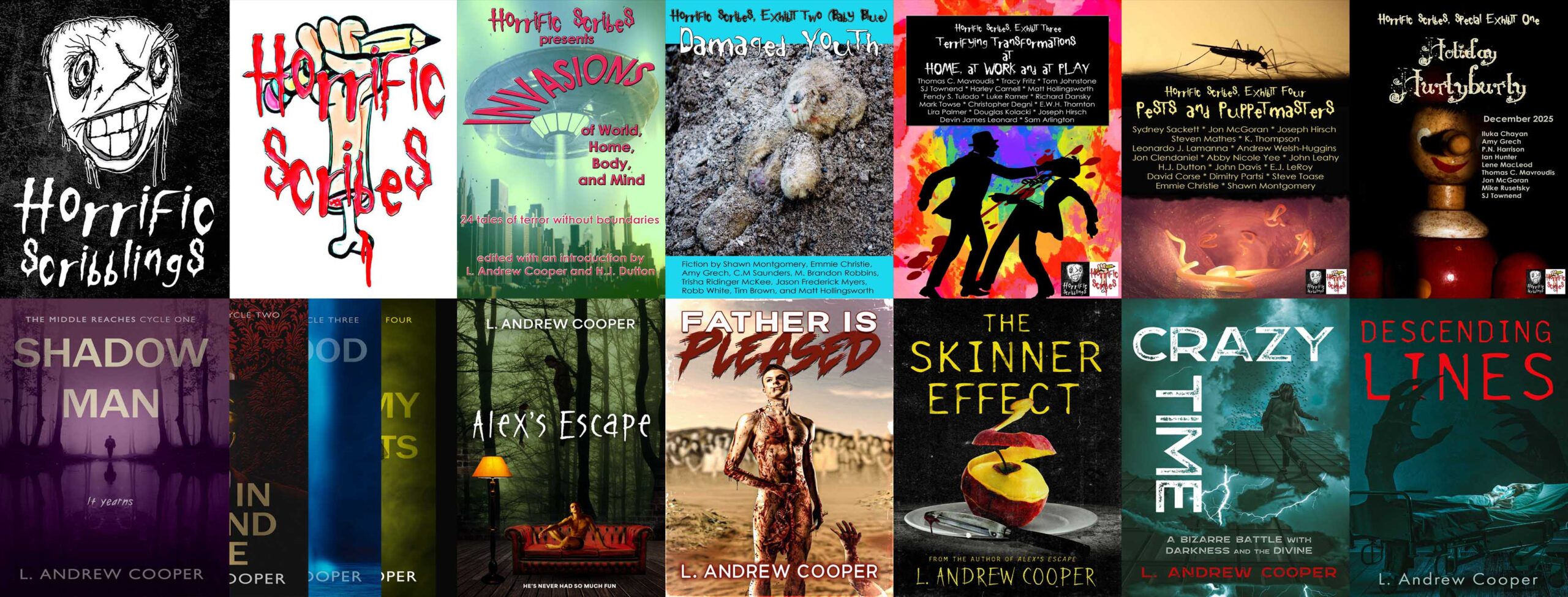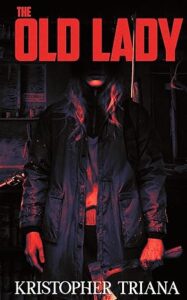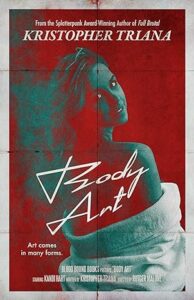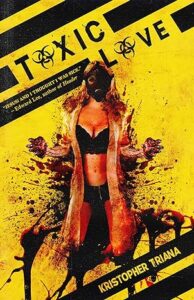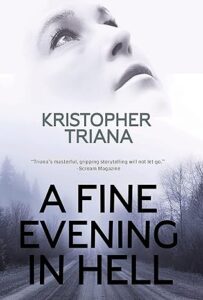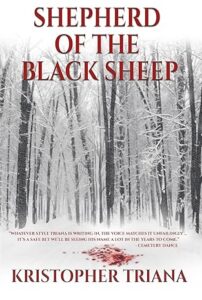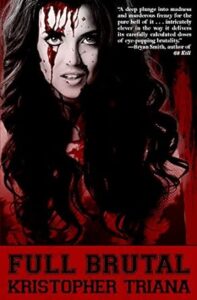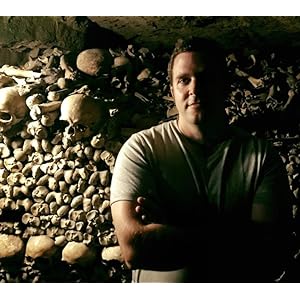Spotlight on Author Kristopher Triana: The Old Lady (2024)
Winner of multiple Splatterpunk Awards, smart and scary Kristopher Triana is here to discuss his just-released novel The Old Lady.
The Old Lady
She never wanted to come home.
After the death of her estranged father, Tracey returns to the remote cabin she grew up in. As a traumatized veteran of the Vietnam War, Tracey’s father subjected her to rigorous survival training under brutal conditions, believing it was for her own good. She escaped and never looked back. Now in her fifties with a criminal record, Tracey returns to claim the property she’s inherited.
Hiking through the forest, teenage Alicia and her friends get lost in the snow. They stumble upon a compound run by extremists, and when the teens see too much, only Alicia manages to escape. She searches for help and comes across a secluded cabin.
With the panicked girl banging on her door, Tracey is launched into combat mode, awakening her inner demons. Though she suffers from extreme PTSD, she is skilled in combat, making her a deadly adversary—perhaps too deadly. As a snowstorm hammers down, the women must work together to save Alicia’s friends from their captors.
Alicia has a protector now, but what if this strange old lady is even more dangerous than the people she’s escaped from?
The Old Lady is a new tale of survival horror from Kristopher Triana, author of Gone to See the River Man and Full Brutal, and columnist for Backwoods Survival Guide.
The Interview
Traumatic Story, Traumatized Characters.
ANDREW: The description of The Old Lady arguably links Tracey’s father’s “traumatized” status to the “brutal conditions” of her childhood and Tracey’s own “extreme PTSD” to how “dangerous” she is. How would you describe The Old Lady’s representation of trauma?
KRIS: I like to think it’s a realistic, sympathetic examination of trauma and the lasting effects of it. Everyone has bad memories and personal pain, but trauma is much deeper than that. With the character of Tracey, I delved into the struggles people with trauma face, including some stuff from my own personal experiences with it. Sometimes we must show the ugly side of things to tell the story accurately.
ANDREW: Do characters’ experiences with trauma contribute to their capacities for violence? Why or why not?
KRIS: No, not always. People with trauma or mental illness aren’t automatically more violent than anyone else. But from a character standpoint, a traumatic past can help explain a character’s reactions to certain situations or threats, reactions that may seem irrational or out of proportion to others who haven’t experienced what they have. In the case of Tracey in The Old Lady, her traumas are plentiful and extreme. She’s endured more than your average person can even fathom. Her violence is reactionary, but her skills at combat stem from her survival training, not her trauma.
ANDREW: How do you feel about the representation of mental illness in horror more generally?
KRIS: I find that mental illness is too often demonized by horror entertainment. Most of the time when we see characters with mental illnesses, they’re complete maniacs in asylums that look more like haunted house attractions than care facilities. As someone who suffers from bipolar disorder, I find such representations insensitive, and as a horror writer, I find them lazy and unimaginative. Negative portrayals like these only further perpetuate the inaccurate, hateful idea that people with mental illnesses are monsters to be feared.
Versus Nature.
ANDREW: After reading Gone to the See the River Man and gearing up for The Old Lady, I see that hiking is again a feature, and characters are going to face a snowstorm. I flash back to middle school and identify “humanity versus nature” as a central conflict. What draws you to such settings and conflicts?
KRIS: There’s something primal about the woods. The only thing you can rely on there is yourself. I like how nature forces us to revert to humankind’s old ways in order to survive. People fear being alone in the woods because there are no safety nets like the ones we have in our so-called civilized world. The woods are dangerous, cold, and dark, reminding us that our lives could be that way so easily.
ANDREW: How central is such conflict to The Old Lady?
KRIS: It’s a huge element.
ANDREW: What does it add to the story, particularly the horror factor?
KRIS: The story takes place deep in the White Mountains of New Hampshire during a terrible snowstorm. Extreme weather is scary in and of itself, so it’s always a welcome addition to any good horror story. Just look at John Carpenter’s The Thing or White by Tim Lebbon. The snow in those stories is as much a threat as the monsters.
ANDREW: In Gone to See the River Man, the line between natural and supernatural gets blurry—can readers expect the same in The Old Lady?
KRIS: No. The Old Lady takes place in a real world setting and has no supernatural elements. But the horror is just as disturbing, transgressive, and brutal as anything I’ve ever written, and I think the story’s realism makes the violence hit that much harder. This is a brutal nightmare that could happen to any of us at any time.
Survivalism.
ANDREW: With Tracey and her father, The Old Lady peeks into the world of survivalists and survivalism. What’s your view (as a contributor to the Backwoods Survival Guide) of survivalist culture, and does your novel reflect that view?
KRIS: I have an interest in survival techniques. I love the outdoors and have always strived to be as self-reliant as possible. I like to do things for myself, fix things myself, figure things out myself. Some of that comes from being a loner, but another part is just an old school mentality regarding what it means to be a man. Much like Tracey’s father in The Old Lady, my father was a Vietnam Veteran, and his experiences in that war changed him for life. We always had canned goods, gallons of water, and enough guns to open our own store if we wanted to. As I got older, I grew to respect the survival mentality more, especially after living through several natural disasters. Some people laugh at those of us who prepare for the worst, but when the worst happens, the laughter stops, and we’re the first ones who get called on for help. Let’s just say that when the Covid shortages hit, I was never short on toilet paper.
ANDREW: Does the novel suggest any relation between survivalism and the “extremist” culture that Alicia encounters? If so, what’s the connection? If not, how do you avoid parallels?
KRIS: There is a stigma that comes with being a survivalist. There are people who automatically assume you’re an alt-right loon just for having the tools and supplies needed to take care of yourself and your loved ones. But those people are only kept safe in times of crisis by people more diligent than themselves. That said, there are certainly the extremists types out there. In The Old Lady, I tried to show both sides of this. I show how useful prepping and survival skills really are to everyday people, but also feature demented militia characters who use survival skills in their acts of terror.
Survival Horror, pt. 1.
ANDREW: Amazon advertises The Old Lady as “survival horror.” How does “survival horror” relate to splatterpunk/hardcore/extreme horror?
KRIS: Survival horror is exactly what it sounds like. In a way, all horror is survival horror, because if the protagonist fails, they die. But true survival horror involves anti-heroes, not simple victims. A good example of a survival horror story is Richard Matheson’s I Am Legend—the last man on earth struggling to survive in a world overrun by vampires. He’s not just running—he’s fighting back.
ANDREW: How hardcore is The Old Lady?
KRIS: It’s not as gross or sexually aberrant as say, Body Art or Toxic Love, but the violence is extremely brutal, and the gore runs like a red river. Characters are mutilated, set on fire, tortured, and blown to bits. Fans of my hardcore works will not be disappointed. But the book also has layered characters and a realistic storyline, making it more like a sister book to A Fine Evening in Hell or Shepherd of the Black Sheep.
ANDREW: How do you feel The Old Lady connects to your other works? With which of your works does The Old Lady resonate most?
KRIS: I think it’s the perfect balance between the hardcore, unhinged horror of Full Brutal and the grim realism of A Fine Evening in Hell.
Survival Horror, pt. 2.
ANDREW: The term “survival horror” has gotten around some, actually. It makes me think of video games, which is the realm where I probably encountered the term first. It also makes me think of one of the terms applied to films like those in the Saw franchise when people are trying to be nice. How might video games, films, or other media have influenced The Old Lady?
KRIS: I’m not a gamer, but I can understand why you’d connect the two. I think the 1980s one-man-army movies I loved as a kid played a big role in the development of this story, especially the Rambo movies.
ANDREW: More generally, what artists and/or works would you say had the greatest impact on this novel’s story and style?
KRIS: Jack Ketchum and David Morrell. Two authors I’ve admired for decades now.
Writing Women.
ANDREW: Many of your stories’ protagonists are women. Why do you focus on female characters? What insights drive your representation of women’s perspectives?
KRIS: Many years ago, I made it a point to write female characters better. So, I started reading more books written by women, especially horror books. It helped me better understand not just female writers but female readers. Since then, I’ve been attracted to female-lead narratives. I think strong female characters are underrepresented by male authors, and in the world of horror fiction, women are too often just final girls/victims. I like to give them much more to do, including having them be the ones swinging the axe!
ANDREW: Do you feel you return to women’s perspectives so often in your work more by coincidence or by design? Why?
KRIS: I just go where the story takes me. It reveals which characters will be the most interesting and fun to write. Sometimes they’re women, sometimes not.
Collaboration.
ANDREW: In The Old Lady, Alicia and Tracey “must work together,” suggesting that collaboration may be a key component of the book’s vision for survival. What do you think the book says about collaboration, particularly across a generational divide?
KRIS: Working together is key to any group’s survival. In The Old Lady, Alicia and her friends work with Tracey, but they are teenagers, and Tracey is in her late fifties. In their eyes, she’s an old lady. But she has survival skills the teens do not, so they rely on her to get them through this horrific experience. I also think it’s a little bit of the old man in me trying to prove a point to young people that they don’t know everything, shouldn’t rely on computers so much, and should at least listen when older people give them advice, because with age comes experience and wisdom.
ANDREW: You’re no stranger to collaboration, having taken home a Splatterpunk Award for The Night Stockers, which you co-authored with Ryan Harding, and being involved in a collaboration with Wrath James White (I get White’s newsletter). How do you feel about the collaborative writing process compared to going solo?
KRIS: A collaboration can be a lot of fun and produce an exceptional final product, particularly when you’re working with people you like and admire for the skills they bring to the table. Ryan and Wrath are both friends of mine, so we have a lot of laughs working together. There’s a bond that comes with creating something as a duo, whatever it is. But you must have the right partner, someone who works at the same pace and wants the project to go in the same direction as you do.
ANDREW: Can you reveal anything about your work with White?
KRIS: Just that it will be as bloody, sexy, and deranged as you’d expect from a White/Triana collab!
Future.
ANDREW: Speaking of revelations, what else are you working on?
I have a collaborative work with Mona Kabbani coming out this spring, in which we both wrote separate novellas with same theme—what we call “extreme horror romance.” And a new solo novel will likely come out before the year ends, too. There are other projects, but none I can divulge at this time.
ANDREW: Where can readers, returning and new, expect to follow you once they’ve enjoyed The Old Lady?
KRIS: Follow my free Substack newsletter for updates and exclusive content.
Access.
ANDREW: And speaking of following you… how can readers learn more about you and your works (please provide any links you want to share)?
SUBSTACK: https://kristophertriana.substack.com
FACEBOOK: https://www.facebook.com/reverendgator
INSTAGRAM: https://www.instagram.com/kristopher_triana/
TIKTOK: https://www.tiktok.com/@kristophertriana
About the Author
Kristopher Triana is an author of horror and crime fiction.
His novels include Full Brutal (Winner of the 2019 Splatterpunk Award for Best Horror Novel), Gone to See the River Man, Shepherd of the Black Sheep, The Thirteenth Koyote, and many more. He has authored two short story collections, Blood Relations and Growing Dark, the latter of which was called “a must read” by Rue Morgue Magazine. His books have been translated into multiple languages, and his short stories have appeared in many magazines and anthologies, including Chiral Mad 4, Cemetery Dance, and The Year’s Best Hardcore Horror, to name a few.
His work has drawn praise from Publisher’s Weekly, Scream Magazine, Rue Morgue Magazine, Cemetery Dance, The Horror Fiction Review, and The Ginger Nuts of Horror.
He lives in Connecticut.
Follow him at: kristophertriana.com
Review of The Old Lady
While I love Gone to See the River Man, which seems to be Kristopher Triana’s most popular work to date, The Old Lady puts Triana on a different level. It’s got the brutal violence that many of his fans will expect, but what really makes it such a great read are its immersive descriptions of an antagonistic setting and its masterful development of characters, good guys and bad guys, but especially the titular lady, Tracey, who doesn’t fit easily into good or bad molds but is likely to have you cheering for her anyway.
I’ve never had to hike up and down a mountain during a blizzard, especially not with people trying to kill me, but Triana’s writing made that experience feel very real and accessible, and I found the prospect of freezing to death just as scary as the possibility of being brutalized by an extremist with a machine gun. The details of the cabin that Tracey inherits from her survivalist/prepper father, along with the surrounding terrain and the ways that Tracey and her father are skilled at traversing and manipulating it, are also absolutely riveting, again far from my experience but totally convincing in Triana’s deft treatments, lending both fascination and excitement to the narrative. I often found myself wishing I could handle natural terrain and survival tactics as well as Tracey. The lady has serious problems, but her relationship with her surroundings makes her unquestionably cool.
On the subject of Tracey’s problems, Triana is particularly adept at depicting her psychological states, which are troubled by what the book’s back cover rightly describes as “extreme PTSD” as well as moments on the sliding scale from delusion to psychosis. This territory is a little more familiar to me: I’ve experienced nothing nearly as horrific as Tracey, but I do have PTSD, and I think Triana’s depiction of it is fair, sympathetic but not distracted by any need to be politically correct. Pushed as far as Tracey has been pushed, I can see myself reacting like Tracey reacts, and I don’t think readers need to have a history of PTSD to have the same feelings while they dig into Triana’s insightful prose.
The book’s exploration of trauma doesn’t stop with Tracey. A group of teenagers, among whom young Alicia is the standout, gets lost on the blizzard-blighted mountain and comes across the deadly extremists, from whom Tracey eventually decides she must save them. Without giving away specifics, I’ll say these teens are severely traumatized by what unfolds, and Triana handles their reactions with subtlety and sophistication. Meanwhile, the teens must also grapple with Tracey, their would-be savior who seems a little off the rails. Triana captures their youthful confusion while developing a relationship between Alicia and Tracey—explicitly cast in mother-daughter terms—that is heart-wrenching.
I don’t want to do any damage to the book in the eyes of fans who dislike such descriptions, but I wouldn’t hesitate to include The Old Lady in a survey of contemporary American literature, horror or otherwise. Yeah, it’s horror—scary and gruesome as hell. But without being preachy, it’s also deeply insightful about current cultural conditions and the more general human condition in ways that make me think it’s a book that, if given the right exposure, could last. I can’t think of much higher praise.
